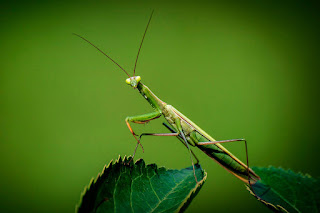
Praying mantis is a type of an insect which is closely related to mantids, termites, and cockroaches. There are 2000 species of praying mantis and almost all of them inhabit tropical and subtropical areas. Praying mantises live in America, Africa, Europe, Asia and Australia. They can be seen in grasses, forests, gardens and other green areas. Praying mantises are not listed as endangered species.
The word mantis comes from the Greek mantikos, for soothsayer or prophet. Indeed, these insects do seem spiritual, especially when their forelegs are clasped together as if they’re in prayer.
Average lifespan of the praying mantis in the wild is 12 months.
Of approximately 2,000 species of mantids described to date, almost all are tropical creatures.
Praying mantis lays case with 300 eggs in the fall. They turn into nymphs in spring. Nymphs look like miniature version of adult insects, but without wings. After molting for couple of times, nymph will transform in the adult insect with wings.
Just 18 native species are known from the entire North American continent.
Praying mantises are probably the best known by the fact that female eats male’s head during sexual intercourse.
That does not happen that often (there are only 30% chance that female will attack the male in the wild) and it is not essential part of the intercourse. Besides ingesting large amount of nutritional proteins, female prolongs the intercourse by eating male’s head, because nerves which stimulate copulation are located in the male’s abdomen (away from the head).
About 80% of all members of the order Mantodea belong to a single family, the Mantidae.
Main predators of the praying mantis are owls, frogs, monkeys and bats.
The Chinese mantis was introduced near Philadelphia, PA about 80 years ago.
When threatened, praying mantis will stand on its hind legs and spread its front legs to scare the predator. If this tactic is not effective enough, praying mantis will strike using its front legs and try to bite and pinch the predators.
The European mantid is pale green and about half the size of the Chinese mantid.
Praying mantis has a single ear on the bottom of its abdomen. It cannot detect location, direction or frequency of the sound, but it may detect ultrasound.
European mantids were introduced near Rochester, NY nearly a century ago.
Praying mantis eats different kinds of insects: grasshoppers, crickets, flies, moths, and caterpillars. Some people use praying mantis in pest control in their yards, but besides pests, praying mantis can eradicate some very beneficial insects, such as bees.
Mantids can turn their heads a full 180 degrees.
Praying mantis is a small insect that reaches between 0.5 to 6 inches in length.
The female praying mantis deposits her eggs on a twig or stem in the fall and then protects them with a Styrofoam-like substance she secretes from her body.
Color of the praying mantis varies from brown to green, depending on its habitat. Color of the body provides camouflage and enables praying mantis to blend with its environment and become invisible for both the predators and the prey.
The earliest fossil mantids date from the Cretaceous Period and are between 146-66 million years old.
Praying mantis has segmented body (body divided in several parts) that consists of head, thorax and abdomen.
Praying mantis can and will consume lots of other invertebrates in your garden, so they’re often considered beneficial predators.
Praying mantis has triangular head (shaped like triangle) with large compound eyes. It has excellent eyesight and it is able to detect the movement at the distance of 60 feet.
A praying mantis has two large, compound eyes that work together to help it decipher visual cues. But strangely, the praying mantis has just a single ear, located on the underside of its belly, just forward of its hind legs.
Color of the praying mantis varies from brown to green, depending on its habitat. Color of the body provides camouflage and enables praying mantis to blend with its environment and become invisible for both the predators and the prey.
The praying mantis cannot discriminate the direction of a sound, nor its frequency.
Praying mantis is a small insect that reaches between 0.5 to 6 inches in length.








